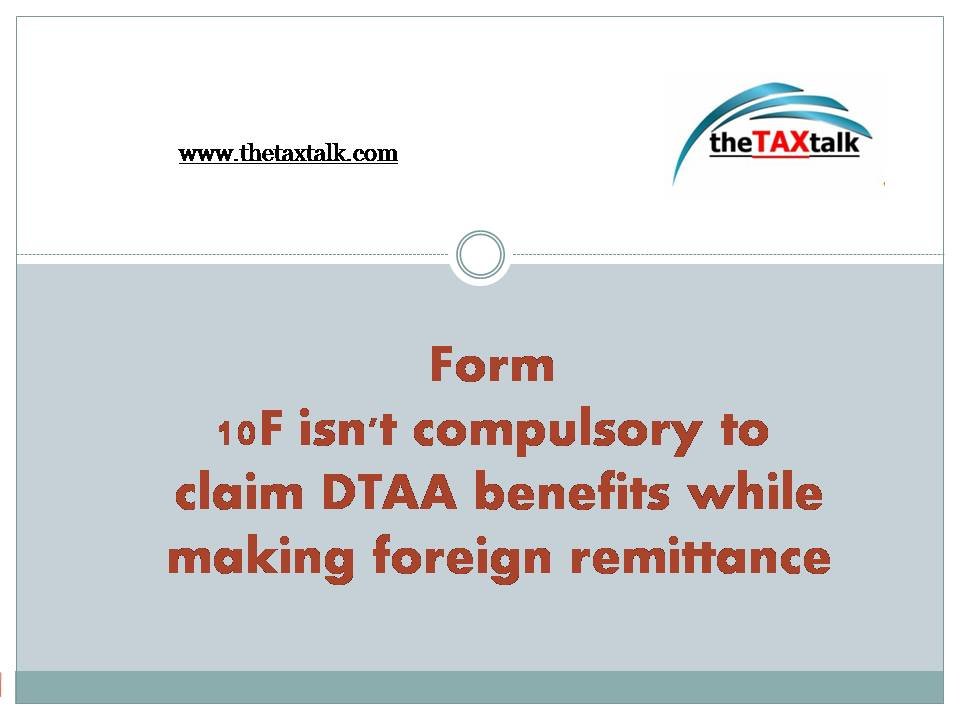![]()
Form 10F isn’t compulsory to claim DTAA benefits while making foreign remittance
While there has been a recent buzz in the industry over the government’s move of mandating the furnishing of Form 10F electronically, many people are unaware of the basic fact that the aforesaid form [as per section 90(5)] is only required to be furnished if the Tax Residency Certificate (TRC) furnished by the Non-Resident payee in accordance with section 90(4), does not contain certain information as prescribed in Rule 21AB(1). This is also stated in rule 21AB(2).
The prescribed list of information has been delineated below:
(i) Status (individual, company, firm etc.) of the assessee;
(ii) Nationality (in case of an individual) or country or specified territory of incorporation or registration (in case of others);
(iii) Assessee’s tax identification number in the country or specified territory of residence and in case there is no such number, then, a unique number on the basis of which the person is identified by the Government of the country or the specified territory of which the asseessee claims to be a resident;
(iv) Period for which the residential status, as mentioned in the certificate referred to in sub-section (4) of section 90 or sub-section (4) of section 90A, is applicable; and
(v) Address of the assessee in the country or specified territory outside India, during the period for which the certificate, as mentioned in (iv) above, is applicable.
Thus, if your TRC contains the aforesaid information, you need not furnish Form 10F. The CBDT on 12th December 2022, provided relief to the NR taxpayers not having PAN in India to furnish Form 10F electronically, till 31st March 2023. The NR taxpayers now need to ensure that the aforesaid information is a part of the TRC and they shall remain exempt from the need of getting a PAN in India for the purpose of availing tax benefits.
[7:21 am, 25/12/2022] Naresh Naresh Sir: Only gross margin can be disallowed in the case of bogus purchases:
M/s. Accra Pac (India) Pvt. Ltd. v. D.C.I.T [ITA No. 514/Ahd/2018]
Facts:
- During the Financial Year 2010-11 the Appellant had purchased chemicals amounting to INR 7,71,22,502/- from one of the suppliers.
- The AO during the course of assessment observed that the Appellant has not furnished the PAN number of such supplier. Further, the supplier has shut the business and therefore, came to the conclusion that purchases were not genuine and should be added back to the income of the Appellant on the ground of bogus purchases as the Appellant was not able to prove the identity of the supplier.
- The Appellant contention was that, since the Appellant’s outward sales is taxable and the Appellant is subject to Excise and tax Audit where auditors had not made any adverse opinion, therefore, the AO cannot add the entire purchases to the income of the Appellant.
- Further, the appellant contended that in case if the impugned amount is to be added then it should be restricted to reasonable amount as the Appellant only had gross profit margin of 7.63% of the turnover.
ITAT Ahmedabad held as below:
- The purchases were utilized for making the final finished product which is subject to tax and only the profit element should be added back to the income.
- The balances standing at the end of the year in the balance sheet of the assessee were audited. Further, the bankers have confirmed the year end balances which tallies with the balances as per the books of the Appellant.
- A certain percentage of such alleged bogus purchases may be disallowed, keeping into consideration the profit offered to tax by the Appellant.
- Accordingly, in the interest of justice, 10% of the purchases may be disallowed and added back to the income of the Appellant.
- Remanded back the matter to the AO for verifying the correctness of the claim made by the Appellant in the issue of fixed deposit mis-match.

